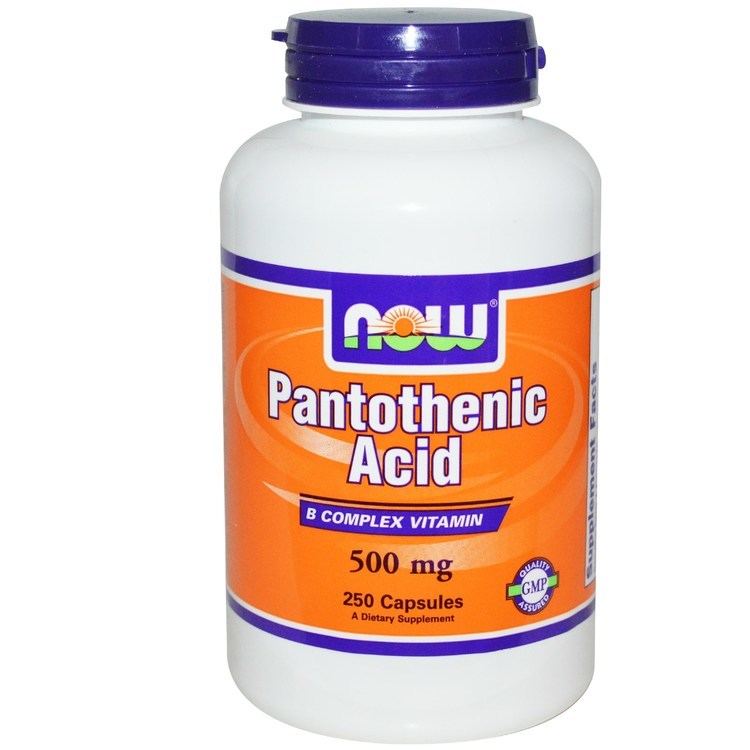3DMet B00193 Formula C9H17NO5 Melting point 183.8 °C Density 1.27 g/cm³ | Related compounds Molar mass 219.23 g/mol Boiling point 551.5 °C Soluble in Water | |
 | ||
Appearance Yellow oil
Colorless crystals (Ca salt) Related alkanoic acids IUPAC ID 3-[(2,4-dihydroxy-3,3-dimethylbutanoyl)amino]propanoic acid | ||
Pantothenic acid benefits side effects acne deficiency
Pantothenic acid, also called vitamin B5 (a B vitamin), is a water-soluble vitamin. Pantothenic acid is an essential nutrient. Animals require pantothenic acid to synthesize coenzyme-A (CoA), as well as to synthesize and metabolize proteins, carbohydrates, and fats. The anion is called pantothenate.
Contents
- Pantothenic acid benefits side effects acne deficiency
- Biological role
- Absorption
- Deficiency
- Toxicity
- Research
- Ruminant nutrition
- References

Pantothenic acid is the amide between pantoic acid and β-alanine. Its name derives from the Greek pantothen, meaning "from everywhere", and small quantities of pantothenic acid are found in nearly every food, with high amounts in fortified whole-grain cereals, egg yolks, liver and dried mushrooms. It is commonly found as its alcohol analog, the provitamin panthenol (pantothenol), and as calcium pantothenate.

Pantothenic acid was discovered by Roger J. Williams in 1933.
Biological role

Only the dextrorotatory (D) isomer of pantothenic acid possesses biologic activity. The levorotatory (L) form may antagonize the effects of the dextrorotatory isomer.

Pantothenic acid is used in the synthesis of coenzyme A (CoA). Coenzyme A may act as an acyl group carrier to form acetyl-CoA and other related compounds; this is a way to transport carbon atoms within the cell. CoA is important in energy metabolism for pyruvate to enter the tricarboxylic acid cycle (TCA cycle) as acetyl-CoA, and for α-ketoglutarate to be transformed to succinyl-CoA in the cycle. CoA is also important in the biosynthesis of many important compounds such as fatty acids, cholesterol, and acetylcholine. CoA is incidentally also required in the formation of ACP, which is also required for fatty acid synthesis in addition to CoA.

Pantothenic acid in the form of CoA is also required for acylation and acetylation, which, for example, are involved in signal transduction and enzyme activation and deactivation, respectively.
Since pantothenic acid participates in a wide array of key biological roles, it is essential to all forms of life. As such, deficiencies in pantothenic acid may have numerous wide-ranging effects.
Absorption

When found in foods, most pantothenic acid is in the form of CoA or acyl carrier protein (ACP). For the intestinal cells to absorb this vitamin, it must be converted into free pantothenic acid. Within the lumen of the intestine, CoA and ACP are hydrolyzed into 4'-phosphopantetheine. The 4'-phosphopantetheine is then dephosphorylated into pantetheine. Pantetheinase, an intestinal enzyme, then hydrolyzes pantetheine into free pantothenic acid.
Free pantothenic acid is absorbed into intestinal cells via a saturable, sodium-dependent active transport system. At high levels of intake, when this mechanism is saturated, some pantothenic acid may also be absorbed via passive diffusion. As intake increases 10-fold, however, absorption rate decreases to 10%.
Deficiency
Pantothenic acid deficiency is exceptionally rare and has not been thoroughly studied. In the few cases where deficiency has been seen (victims of starvation and limited volunteer trials), nearly all symptoms can be reversed with the return of pantothenic acid.
Symptoms of deficiency are similar to other vitamin B deficiencies. There is impaired energy production, due to low CoA levels, which could cause symptoms of irritability, fatigue, and apathy. Acetylcholine synthesis is also impaired; therefore, neurological symptoms can also appear in deficiency; they include numbness, paresthesia, and muscle cramps. Deficiency in pantothenic acid can also cause hypoglycemia, or an increased sensitivity to insulin. Insulin receptors are acylated with palmitic acid when they do not want to bind with insulin. Therefore, more insulin will bind to receptors when acylation decreases, causing hypoglycemia. Additional symptoms could include restlessness, malaise, sleep disturbances, nausea, vomiting, and abdominal cramps. In a few rare circumstances, more serious (but reversible) conditions have been seen, such as adrenal insufficiency and hepatic encephalopathy.
Deficiency symptoms in other nonruminant animals include disorders of the nervous, gastrointestinal, and immune systems, reduced growth rate, decreased food intake, skin lesions and changes in hair coat, and alterations in lipid and carbohydrate metabolism.
Toxicity
Toxicity of pantothenic acid is unlikely. In fact, no Tolerable Upper Level Intake (UL) has been established for the vitamin. Large doses of the vitamin, when ingested, have no reported side effects and massive doses (e.g., 10 g/day) may only yield mild intestinal distress, and diarrhea at worst. It has been suggested, however, that high doses of pantothenic acid might worsen panic attacks in those with panic disorder by prolonging the duration until adrenal exhaustion. Pantothenic acid, at a human equivalent dose within the range of common supplementation, was shown to induce adrenal hyper-responsiveness to stress stimulation. There are also no adverse reactions known following parenteral (injected) or topical (skin) applications of the vitamin.
Research
Although pantothenic acid supplementation is under preliminary research for a variety of human diseases, there is insufficient evidence to date that it has any effect.
Ruminant nutrition
No dietary requirement for pantothenic acid has been established as synthesis of pantothenic acid by ruminal microorganisms appears to be 20 to 30 times more than dietary amounts. Net microbial synthesis of pantothenic acid in the rumen of steer calves has been estimated to be 2.2 mg/kg of digestible organic matter consumed per day. The degradation of dietary intake of pantothenic acid is considered to be 78 percent. Supplementation of pantothenic acid at 5 to 10 times theoretic requirements did not improve performance of feedlot cattle
